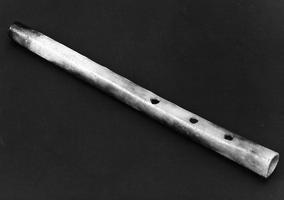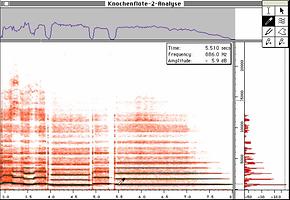Roman Times#
Bone flute from Flavia Solva#
The bone flute with three finger holes dates back to the second century A.D. and was found in excavations in Flavia Solva. It is preserved in the Joanneum Museum in Graz.
The sonagram clearly shows the fundamental (green) and the first four overtones (orange). The curve above shows the sound wave of one channel (mono recording). The red curve on the side demonstrates the waves for the time that is marked by the eprouvettes.
The third illustration represents the sound spectrum of the wave's progress. At first, the fundamental and the four overtones can be clearly recognized. The other highpoints only represent the sounds that are caused by beginning to blow into the instrument. As the tone dies out, the overtones disappear one after the other. (E. Stadler)
Sound Clip#


